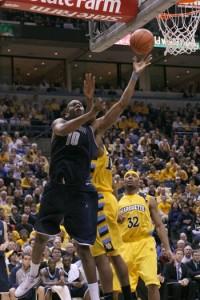In Georgetown’s recent loss to Marquette, its fifth defeat in a row, the Hoyas twice allowed the Golden Eagles to go on game-changing runs: a 12-2 spurt over 2:26 in the first half that saw Georgetown go from up nine to down one, and a 19-5 run over 6:26 in the second half that moved the Hoyas from three points ahead to 11 points behind.
Runs such as these have not been uncommon during Georgetown’s 2009 struggles. Indeed, the Hoyas’ seven January losses were marked less by their opponents gradually pulling away and more by stretches, usually late in the first half or midway through the second, where the opposition thoroughly dominated and, in many cases, took control of the game for good.
“In our league, there are going to be runs,” Georgetown Head Coach John Thompson III said after losing to Notre Dame. “Every team is potent offensively and we are going to face runs and we just have to weather that, stay composed, and make one of our own.”
In fact, as Thompson alluded to, it is not an absence of opposition runs that has defined the Hoyas’ two signature wins – at Connecticut and against Syracuse – but rather Georgetown’s ability to withstand and limit them, and to make runs of its own.
Perhaps it comes as no surprise that Georgetown can withstand runs in wins and cannot in losses. But the degree to which the Hoyas have been hurt by those difficult stretches has been particularly pronounced. If the Hoyas are going to turn the season around over their final 10 games, they will need to cut out the extended lapses. That starts tonight with a 7 p.m. home bout against Rutgers (10-12, 1-8 Big East).
The numbers bear this out. Pittsburgh took control of its Jan. 3 win over Georgetown with a 17-4 run over 6:54 in the middle of the second half. Notre Dame reeled off a 16-3 stretch over 6:45 at the end of the first half and a 10-2 run over 2:48 in the second stanza.
Duke used a 21-2, 9:12 run that spanned halftime to take control on Jan. 17. And after the Hoyas crawled back into the game, the Blue Devils went on a 15-3 run, jumpstarted by the infamous technical on freshman center Greg Monroe, to extend their lead from four to 16 with 10:40 remaining.
West Virginia had two 12-3 second-half runs in its win over Georgetown. Seton Hall closed the first half on a 6-0 spurt and then erased the Hoyas’ seven-point lead and turned it into a four-point advantage for the Pirates with a 13-2 spree over 5:09 in the middle of the second.
And last Wednesday, Cincinnati finished the game with an 11-2 closing statement.
So there’s no denying that Georgetown has struggled to keep its opponents from making runs. The better question is why the Hoyas have surrendered such crippling stretches.
ore than anything, it has been laziness that has defined these Georgetown lapses. Not laziness in the sense that players have stopped trying, but the Hoyas have bailed out opposing defenses too early in possessions, settling instead for ill-advised threes, and have failed to move their feet on defense, sometimes resulting in too many open shooters, but other times leading to problematic early foul trouble.
During Pittsburgh’s 17-4 run, Georgetown missed four three-pointers. While Notre Dame reeled off a 16-3 edge, the Hoyas erred on three treys and a long two-pointer. As the Blue Devils dominated 21-2 for over nine minutes, Georgetown missed another three long balls. Maybe worst of all, the Hoyas missed four threes in five minutes during Seton Hall’s run.
For long stretches in each of these games, Georgetown’s offense appeared stagnant, with too much standing around and not enough cutting. The Hoyas have also made far too many terrible passes, with junior forward Summers and sophomore guard Austin Freeman making some of the most memorably egregious ones, but there is plenty of blame to spread around.
On the other end of the floor, the Hoyas have not played the smothering defense they had been known to play. Against Notre Dame, Duke and Marquette, that meant too many three-pointers surrendered. Duke and Marquette were also able to turn the respect given to their three-point shooters into several easy drives to the basket.
Seton Hall and Marquette attacked the basket during their second-half runs, and Georgetown could not make a stop without committing a foul. The Hoyas committed 15 fouls after the break at Seton Hall and 17 in the second stanza at Marquette.
There is no easy fix for Georgetown. The Hoyas have shown this season that they are capable of running an effective offense; of playing adequate defense; of competing on the glass. Georgetown just needs to do so more consistently.
Thompson has identified two intangible traits that should help the Hoyas. After the West Virginia loss, he said his team needed to respond better to missing shots, and not let offensive struggles affect Georgetown on the defensive end. The Hoyas need to heed their coach’s advice.
Second, in describing Marquette’s veteran guards, Thompson said that the Golden Eagles “understand that the key possessions of the game might be at the 11-minute mark, not necessarily the two-minute mark.” Georgetown must begin to show a greater sense of urgency when it feels like the game is getting out of control, and buckle down so that a few easy buckets don’t turn into a prolonged run.
Despite Marquette’s two killer runs, Georgetown did seem to play better against the Golden Eagles than it had against Seton Hall or Cincinnati, especially on the offensive end. Tonight against Rutgers is the Hoyas’ first chance to show they have turned the corner. Georgetown needs to stop its opponents’ big runs if it is going to make one through the Big East.
Tip-off is set for 7 p.m.
Got an explanation for all these runs? Discuss it over at The Hoya Paranoia.
“








